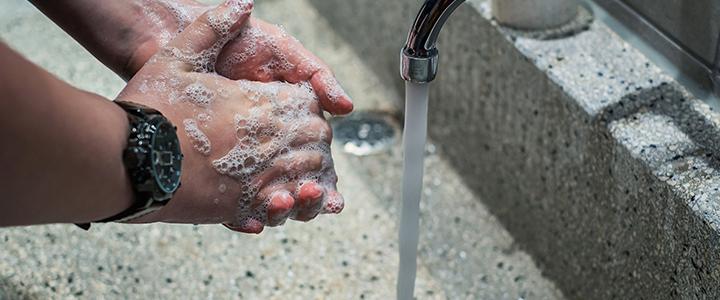
Commissioner's Column: COVID-19 testing in wastewater: what is really going on?
As the COVID-19 pandemic has continued, testing for the presence of the virus has become a key part of effective response. Within the many approaches of testing, environmental surveillance, specifically, the testing of “sewersheds” to determine the possible presence of infected individuals within the area of that sewer system, has become a potentially effective approach. But this approach also has significant challenges. NHDES is working to ensure the public health is protected by carefully monitoring the ongoing research by academic institutions and private companies, and supporting wastewater testing for COVID-19, including performing one-time sampling at select municipal and industrial wastewater treatment facilities for a UNH study.
Environmental surveillance is not a new area of science, but rather something that comprises the work that most of us here at NHDES do every day. For example, in the Water Division, we perform surveillance (and monitoring) as part of our ambient groundwater monitoring and sampling, and our sampling of rivers and lakes to make observations and look for water quality trends over time. We make decisions based on these data with the ultimate goal to protect human health and the environment. Public health surveillance may be used to track emerging health-related issues at an early stage and find active solutions in a timely manner. Surveillance systems are generally called upon to provide information regarding when and where health problems are occurring and who is affected, and wastewater-based surveillance is no different.
Sampling wastewater as a public health surveillance tool is not a new phenomenon either. In the past, it has been used to help understand the spread of illicit drug use and infectious diseases such as MERS-CoV, a relative of COVID-19, adenoviruses and polio, among others. It is important to note that the ability to use it as a surveillance technique to understand viral outbreaks in a community continues to evolve over time with advances in science and data analysis. Using wastewater sampling data in tandem with clinical data from local health departments is critical to maximizing its effectiveness.
What we are looking for in these wastewater samples is not the live or infectious viruses but the inactive genetic material, known as RNA, that is within the enveloped virus. Scientists can determine whether or not these genetic fragments are present or absent and in many cases can quantify the magnitude of RNA concentration.
Surveillance in wastewater is a developing science with researchers, utilities, EPA and the CDC all working together to try to provide meaningful and comparable results that can be useful in detecting th spread of COVID-19. Since the sampling, scientific testing and reporting methods vary greatly across these groups in the US and worldwide, care should be exercised when using discrete results for public health and safety policy decisions. Current methods use wastewater samples from treatment plant influent, building sewer discharges, or other sewer line locations tested for a set of “markers” to detect the unique pieces of RNA that are linked specifically to the SARS-CoV-2 (the Coronavirus causing the disease called COVID-19). Wastewater has not been found to have intact virus particles so detection of these markers is used to indicate when virus may be present in the area sampled. There are many SARS-type Coronaviruses, including some from plants, domestic animals and even the common cold, so the results need to screen out those occurrences and make sure it’s really the human “COVID-19” markers being reported. As with any scientific work, there has to be due diligence exercised to make sure any false positive results from other viruses are identified; particularly when the testing methods themselves have not been certified.
Some other considerations have to do with the sampling. Not to be too indelicate, but someone has to “shed” virus into the sewer (flush) for it to even hope to be detected. Not all people with COVID-19 symptoms have been shown to have virus in their stools and a certain threshold number of the markers has to be found in a lab-concentrated sewer sample for the current test methods to detect it. As you can imagine, a single contaminated flush going into a sewer system could be vastly diluted before it reaches the sampling point – rendering it “invisible” to the test and potentially creating a false negative result. Other considerations include when or how often a sample is taken: Did it miss the contaminated flush altogether? Was the infected individual just traveling through the area, was the individual at work or at home, was the individual symptomatic or asymptomatic? Did the harsh environment of the sewer system break apart the virus’ RNA so much that the markers couldn’t be detected?
All these factors make it difficult to identify the number of infected individuals or relate the results to reported COVID-19 cases in a specific area just by testing discrete sewer samples. Even with all these potential issues, if sampling, testing and reporting results are done meticulously, COVID-19 surveillance using wastewater can help determine presence or absence of the unique virus markers and their increasing or decreasing trends over time. This may allow public health officials, health care facility operators, or university campuses the opportunity to target individual testing or improve protective protocols.
Working with our regional partners, through the New England Interstate Water Pollution Control Commission, with EPA and CDC, with our other state agencies, such as DHHS and New Hampshire Homeland Security and Emergency Management, and with our academic institutions, UNH and Dartmouth, we continue to learn more about both the potential and problems of the approach of COVID-19 testing in wastewater. We currently believe there are significant advantages in cost, usefulness and applicability, but we also caution that there is a lot of fundamental research needed and all users of this approach must be cautious. We will continue to learn, support and distribute accurate information on this important tool. In the meantime, stay safe.




